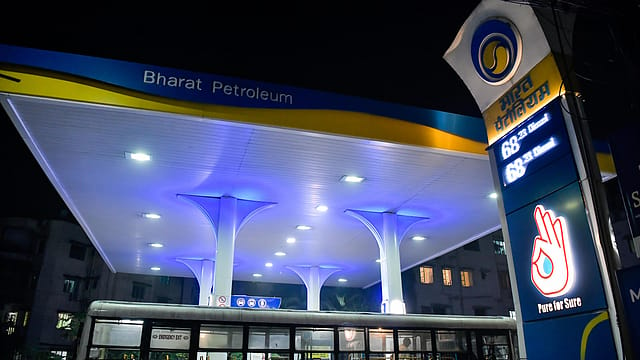The importance of the BPCL stake sale
ADVERTISEMENT

On a day when oil prices plunged and Brent crude touched levels last seen during the great financial crisis of 2007-08, the Indian government invited bids for the strategic sale of its entire 52.98% stake in Bharat Petroleum Corporation Limited (BPCL), the nation’s second largest, government-owned oil refiner.
On Saturday, the day the government invited the bids for BPCL, Brent crude touched $45 a barrel.
“The Government of India is proposing strategic disinvestment of its entire shareholding in BPCL comprising 114.91 crore [1.15 billion] equity shares, which constitutes 52.98% of BPCL’s equity share capital, along with transfer of management control, to a strategic buyer (except BPCL’s equity shareholding of 61.65% in Numaligarh Refinery),” says the bid document of the Department of Investment and Public Asset Management (DIPAM), dated March 7, 2020.
To be eligible for participation, bidders must have a minimum net worth of $10 billion as on date. Besides this, a consortium can bid for the stake, provided it has a maximum of four members—where the lead member has a minimum equity contribution of 40%, while the other members “must have a minimum net worth of $1 billion”, the bid document says.
January 2026
Netflix, which has been in India for a decade, has successfully struck a balance between high-class premium content and pricing that attracts a range of customers. Find out how the U.S. streaming giant evolved in India, plus an exclusive interview with CEO Ted Sarandos. Also read about the Best Investments for 2026, and how rising growth and easing inflation will come in handy for finance minister Nirmala Sitharaman as she prepares Budget 2026.
With this announcement, the government seems to have resolved the complex issues arising from BPCL’s cross-holding various other companies, which was causing some confusion with its valuations. For instance, it has a 12.5% stake in Petronet LNG, 22.5% stake in Indraprastha Gas and 61.6% in Numaligarh refinery (NRL). Now NRL will be a separate government-owned entity, with Oil India, Engineers India, and the Assam government, among others, having a stake in the company.
However, the importance of BPCL’s strategic sale goes much beyond the money that will flow into the government’s coffers, because it will be India’s biggest fuel market reform since 2002, when the first National Democratic Alliance under late Prime Minister Atal Behari Vajpayee deregulated oil prices for the first time. In this case too, for the first time, the new owner will have full management control over BPCL, unlike the earlier disinvestments, when the control continued to rest with the government. Take the case of state-run Hindustan Petroleum Corporation (HPCL). Even after paying ₹36,000 crore for the ownership of HPCL by Oil and Natural Gas Corporation, the new entity remains under government control. It not only means a premium for the government for relinquishing its management control, but more money in the hands of the shareholders, because the new owners will also have to make an open offer.
To ensure a higher participation of foreign players in the privatisation process, the government made changes in the guidelines. For instance, the Cabinet Committee on Economic Affairs (CCEA) approved a new guideline, which allows the government to issue licences for transportation fuel to players, without having to invest ₹2,000 crore in the petroleum sector, as was the case earlier.
International oil companies such as Saudi Aramco or others, which did not meet the eligibility conditions earlier, can now bid to access 15% of India’s oil refining capacity and about one-fourth of the fuel market share in the world’s fastest-growing energy market. The company operates four refineries with a combined capacity of 38.3 million tonnes per annum, distributes 21% of petroleum products consumed in the country by volume as of March this year, and has more than a fifth of the 250 aviation fuel stations in the country. It also has 15,177 petrol pumps, 51 liquefied petroleum gas (LPG) bottling plants. and 6,011 LPG distributor agencies in the country.
Under the new CCEA guidelines even non-oil firms can enter the arena, which experts say can lure supermarket chains to open petrol stations at malls. Privatising the oil refining and marketing sector will bring in greater competition not just in terms of market share for fuels but also in dealer commissions etc., which has till now been dominated by the public sector. Private players in the fuel retailing space like Reliance, Rosneft-led Nayara Energy, and Shell only have a 10% stake in the market.
The CCEA had also put two conditions for the new entrants that will encourage alternatives or cleaner mobility solutions. The new players will have to offer at least one of the three alternatives to petrol or diesel—electric vehicle charging facility, compressed natural gas (CNG), or liquefied natural gas (LNG) for heavy vehicles—at their retail outlets within three years of becoming operational. Besides, the new entities must set up 5% of their total outlets in rural areas, within five years of starting the business.
The stake sale will follow a two-stage process of first inviting expressions of interest from potential bidders who will after due diligence be asked to put price bids.
